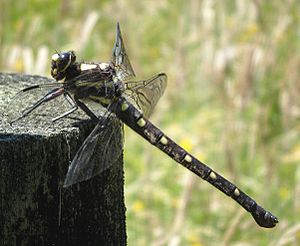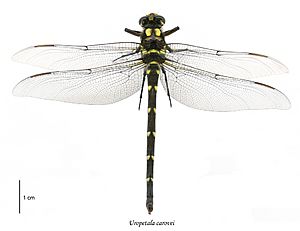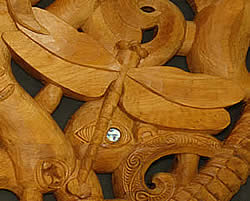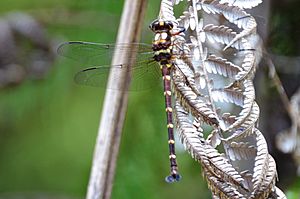New Zealand bush giant dragonfly facts for kids
Quick facts for kids New Zealand bush giant dragonfly |
|
|---|---|
 |
|
| Conservation status | |
| Scientific classification | |
| Genus: |
Uropetala
|
| Species: |
carovei
|
The Uropetala carovei is a super cool insect also known as the New Zealand bush giant dragonfly. It's a type of giant dragonfly that lives only in New Zealand. Its special Māori name is kapokapowai, which means "water snatcher." This name describes how its young, called nymphs, live in water. Like all dragonflies, these nymphs have a long, stretchy jaw that shoots out to grab their food!
What Does It Look Like?
This amazing dragonfly has a body that's yellow and black. It can grow up to 86 millimeters (about 3.4 inches) long. Its wings can spread out to 130 millimeters (about 5 inches) wide! This makes it the biggest dragonfly in all of New Zealand.
Male giant dragonflies have special petal-shaped parts at the end of their bodies. You can tell the Uropetala carovei apart from a similar dragonfly, the Uropetala chiltoni, by looking at its mouth and legs. The Uropetala carovei has an all-black "lip" area (called a labrum). The Uropetala chiltoni has a big pale spot there. Also, the Uropetala carovei has brown or yellowish upper leg parts (called femurs), while the Uropetala chiltoni has black ones.
Where Do They Live?
You can find these giant dragonflies all over New Zealand. They especially like the western parts of both the North and South Islands. They prefer damp areas inside native forests.
Life Cycle and Habits
The young dragonflies, called nymphs, live in a very unique way. They dig tunnels into the soft earth of stream banks or wet areas. Inside these tunnels, they have a little room that's half-filled with water. They stay there for about five years!
Hunting for Food
At night, the nymphs come out of their burrows to look for food near the entrance. They are very shy, so it's rare to see them.
When they are adults, these dragonflies fly slowly and make a bit of noise. They eat smaller insects, like cicadas. They can even catch and eat their prey while flying! But the U. carovei can also become food for other animals. Rats, kingfishers, and even wasps sometimes hunt them.





